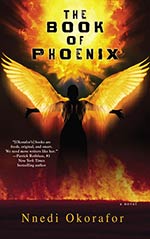
![]() couchtomoon
couchtomoon
9/11/2016
![]()
If Europe at Midnight is the most geopolitically-relevant SF novel of recent times, then The Book of Phoenix is the most sociopolitically-relevant novel I've encountered in a long time. I hesitate to make a grandiose statement like that, because I suspect this observation would bother Okorafor who, based on interviews and introductions, indicates that she prefers her novels to be viewed with fewer sweeping generalizations and more as a lens into the nature of the personal, the story, and storytelling itself. Well, that puts a damper on the way I approach things, which The Book of Phoenix is absolutely ripe for, so I'm wondering if I can successfully toe the line by staying within the confines of the story while at the same time pointing out where my mind went at certain points. So I'm going to hedge more than usual.
A lot of readers quickly latch on to the oral storytelling cadences, the Naijamerican influences, and cross-continental mythological elements, but it should be no surprise that I see a lot of classic sci-fi influence in Okorafor's stories. The Book of Phoenix is no different, not only introducing old sci-fi concepts like strange gadgetry, government oppression, and transhumanism--none of which is unusual in modern-day sci-fi-but they are introduced in a way that is written like old sci-fi (simple, direct language), and portrayed like old sci-fi. Early scenes bring to mind old school evil science labs, genetic tinkering, and government conspiracies that I've enjoyed in old Philip Jose Farmer, Samuel Delany, and Philip K. Dick. Even Seven's death on television in the novel seems like an exact replay of another small screen death of an SF martyr: Mike from Stranger in a Strange Land (what I consider Heinlein's only near-literary moment). Even the relationships of TBoP feel as perfunctory as those in classic sci-fi (and maybe that doesn't sound like a compliment, but sometimes relationships are overwrought to silliness in more modern SF).
Part of this sense of "the old school" is also due to the bold comic book hero motif that emerges early on, where characters take on superpowers, scenery becomes more visually chunky, rather than atmospheric, and scenes are chopped and delineated as if illustrated in panels. For a non-graphic novel reader, whose observation skills diminish when faced with a (gods forbid!) picture, reading in this style is something of a mixed experience: easier to read than a graphic novel, but disappointingly less concentrated with prose and ambience. I suspect this will turn off some readers wanting something chewier.
Additionally, the colloquialism and oral cadences might also turn off typical Clarke readers. Okorafor-a Ph.D. mind you-tends to favor sentences of the broken, repetitive, truncated, and beginning-with-"I" variety. This is a stylistic choice and may be tied to Okorafor's strength as an oral storyteller, which, as I learned with her last novel, Lagoon,(one of my few five-star experiences with audiobooks) works better in the audio format, as the oral rhythms of TBoP open up the prose into a more talkative and demonstrative piece of fiction. (Although some typographic touches, like unexpected capitalizations, will go unseen in the audio format). While Lagoon is a more performative novel, The Book of Phoenix is better approached as spoken word in some sections.
Another element that makes this novel so interesting is Okorafor's choice of symbolism, particularly my favorite symbol of the novel, the tree. While the root of the novel lies in the preoccupation of freedom, a theme that rings throughout the narrative, the very center of the tale is The Backbone, a Gormenghast-like tree that supports and destabilizes Tower 7, where Phoenix is created and imprisoned. It's not so much the tree itself, or even the idea of the tree that I find so disarming, but the label Okorafor uses for it: "The Backbone." The Backbone tree is an element of Phoenix's life that is complicated and consuming; it-like any common backbone- gives her strength, but it also undermines the rest of her structure. It is a symbol of life, freedom, and promise, but it's also a symbol of captivity, injustice, and Phoenix's own paralyzing fury. It brings to mind the belittling advice we've all heard (and said) to "get a backbone," and its many emotional contradictions: to adapt and be resilient, but accept the injustice of the status quo. Like Phoenix's own complex relationship with the tree, it's never quite clear what we should feel about our own Backbones.
You cannot contain The Backbone. But I can burn it and the rest of this remorseless city to ash. They made me here. I will be exactly what they wanted... Let me be the villain for the sake of justice. (105)
But that's just the mouthfeel. More important-what is truly exciting about this work- is the sense that The Book of Phoenix is a dangerous book-in the way that Stand on Zanzibar, Slaughterhouse-5, or The Female Man are dangerous books. A science fiction story about an angry black woman in a burka who wants to blow up the Capitol building and set fire to NYC because of the systematic mistreatment of the domestic and globally colonized is long overdue. This is bold choice for any writer, but how many science fiction writers are daring enough to write "the burka is freedom" or "these people would live forever, infecting the world to its very soul." There is an edginess, a subversiveness, a fury in this novel that I normally only encounter in the literary or memoir aisles. Okorafor is pushing science fiction where I want it to go.
http://couchtomoon.wordpress.com